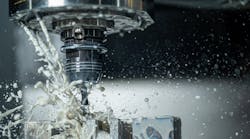As manufacturers continue to pursue digital transformations and automation capabilities continue to mature, could true autonomous machining be on the horizon?
The potential exists. And it could be a crucial step according to the results of a 2020 benchmarking report by MachineMetrics, which revealed an average machine utilization rate of only 24%, an alarmingly low mark that limits manufacturers’ ability to meet demand.
By leveraging IoT tech to autonomously collect data from industrial machines, MachineMetrics sees its future in autonomous machining, where machines predict and diagnose issues and automate the necessary changes. For instance, autonomously ordering new parts or tweaking a production pattern to improve quality.
“Manufacturing is on the brink of a digital renaissance. The intersection of software, big data and physical machinery is the next frontier for manufacturing and a proven solution for overcoming the production and labor shortages we are experiencing right now,” says Bill Bither, co-founder and CEO of MachineMetrics, “Today’s industrial machines are inefficient because they require significant human intervention to operate. MachineMetrics makes it easy to harness data from these machines and lays the foundation for the factory of the future where machines operate autonomously and with predictability.”
Of course, autonomous machining requires a deep understanding of the operation of a machine, materials being machined, types of machining processes, and all of the other adjoining systems, Bither tells IndustryWeek. “There is an infinite number of different machines and processes in the world of manufacturing. Much of this understanding today is tribal knowledge from operators that have worked with machines for decades,” he says.
“These operators are now exiting the workforce, and skilled human replacements are nearly impossible to find. The alternative is well known to be using AI and Machine Learning to replace this tribal knowledge,” says Bither. “Attempts in discrete manufacturing and machining have been made but have all failed. External sensors have been used to capture this data in the past for one-off studies, but have failed to scale across hundreds, let alone thousands of machines. Getting labeled data from operators presents its own challenges at scale.”
According to Bither, the key component for autonomous machining to work is to gain a deep understanding of thousands of different machines and processes in a scalable way. “By using data that already exists in these machines without installing external sensors and developing algorithms that normalize the data into its core components, we can get operational data from the machine,” he says. “By providing a user interface for the operator that’s used every day to accomplish their tasks more effectively, we can get labeled data from when a process malfunctions from thousands of machines at scale, democratizing this tribal knowledge. Both of these components, normalized machine data, and labeled failures, are required to achieve the vision of autonomous machining.”




